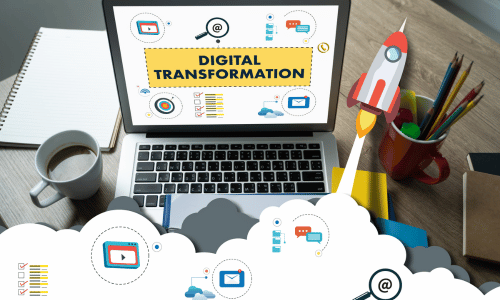
In the realm of modern business, “digital transformation” has evolved from a buzzword to a critical strategy for survival and growth. This phenomenon isn’t just about adopting new technologies; it’s a radical rethinking of how an organization uses technology, people, and processes to fundamentally change business performance.
Why is digital transformation so pivotal? Simply put, it’s a matter of adaptation and competitive edge, in a world where customer expectations are constantly shaped by technology, businesses that refuse to evolve risk falling behind. Consider the transformative impact of digital giants like Amazon and Airbnb, which have reshaped retail and hospitality sectors. But digital transformation isn’t exclusive to such behemoths; it’s equally essential for small and medium-sized businesses aiming to thrive in this digital era.
The purpose of this article is to serve as a comprehensive roadmap, guiding businesses through the intricacies of digital transformation. Whether you’re just beginning to ponder the need for digital adaptation or you’re deep into your transformation journey, this guide aims to provide valuable insights and practical strategies to help you navigate this complex terrain.
Question for Reflection: Is your business ready to embrace the changes and challenges of digital transformation? What steps have you taken, or plan to take, to ensure your business remains relevant and competitive in this digital age?
Section 1: Understanding Digital Transformation

What is Digital Transformation?
At its core, digital transformation involves integrating digital technology into all areas of a business, resulting in fundamental changes to how businesses operate and how they deliver value to customers. Unlike traditional IT management, which is often about using technology to do the same things more efficiently, digital transformation is about using technology to do new things or to do existing things in dramatically different ways.
The Impact of Digital Transformation
- Statistical Insight: According to a report by IDC, global spending on digital transformation technologies and services is expected to reach $2.3 trillion by 2023, indicating the scale and significance of this movement.
- Case Study Highlight: Microsoft’s transformation under CEO Satya Nadella is a prime example. By shifting focus to cloud computing and embracing a “mobile-first, cloud-first” strategy, Microsoft rejuvenated its business model, leading to significant revenue growth and a reestablishment as a tech leader.
Why Businesses Need to Adapt
The digital era has ushered in rapid changes in consumer behaviour and market dynamics. Businesses that don’t adapt risk becoming irrelevant. Here are a few reasons why digital transformation is no longer optional:
- Customer Expectations: Today’s customers expect personalized, seamless experiences across digital channels.
- Competitive Pressure: Competitors who leverage technology effectively pose a significant threat to traditional business models.
- Operational Efficiency: Digital tools and processes can significantly improve efficiency, reducing costs and increasing agility.
- Innovation: Digital transformation opens up new avenues for innovation, helping businesses stay ahead in their industries.
Section 2: Key Components of Digital Transformation

Digital transformation is multifaceted, involving more than just the adoption of new technologies. It’s a holistic change that encompasses technology, culture, and operations. Understanding its key components is essential for any business looking to embark on this journey.
Technologies Driving Digital Transformation
- Cloud Computing: The backbone of digital transformation, cloud computing offers scalable resources, fostering innovation and agility.
- Artificial Intelligence (AI) and Machine Learning: These technologies provide businesses with insights into customer behaviour, improve decision-making, and automate operations.
- Internet of Things (IoT): IoT connects physical assets to the digital world, offering new opportunities for data collection and analysis.
- Blockchain: While still emerging, blockchain holds potential for secure, decentralized transaction and data management.
Cultural Shift: Embracing a Digital Mindset
Digital transformation isn’t just about technology; it’s equally about people and culture. A digital mindset involves:
- Adaptability: Being open to change and willing to evolve with technological advancements.
- Collaboration: Encouraging cross-departmental collaboration to leverage digital tools effectively.
- Continuous Learning: Embracing a culture of ongoing education and skill development in the digital arena.
Employee Engagement in Digital Transformation
Employee involvement is crucial. Staff should be trained and encouraged to think digitally. This includes:
- Training Programs: Offering regular training sessions on new digital tools and methodologies.
- Incentivizing Innovation: Encouraging employees to come up with innovative digital solutions.
- Feedback Loops: Creating channels for employees to provide feedback on digital initiatives.
Section 3: Digital Transformation Strategies

Implementing digital transformation successfully requires a well-thought-out strategy that aligns with your business objectives and addresses the unique challenges your company faces. Here are key strategies to consider:
1. Developing a Clear Vision and Roadmap
- Establish Objectives: Define what digital transformation means for your business. Set clear, achievable goals.
- Create a Roadmap: Outline the steps needed to achieve these goals, including timelines and milestones.
2. Building a Strong Digital Culture
- Leadership Commitment: Ensure top management is committed and visibly leading the digital transformation efforts.
- Empower Employees: Foster a culture where employees are encouraged to innovate and adapt to digital changes.
3. Customer-Centric Approach
- Understand Customer Needs: Use digital tools to gain insights into customer preferences and behaviours.
- Personalize Experiences: Leverage data analytics to offer personalized products and services.
4. Investing in the Right Technology
- Assess Technological Needs: Identify technologies that will most effectively drive your business goals.
- Scalable Solutions: Choose solutions that can grow and adapt to your business.
5. Ensuring Data Security and Compliance
- Robust Security Measures: Implement advanced security protocols to protect sensitive data.
- Compliance: Stay abreast of regulations in your industry and ensure all digital transformations comply.
Section 4: Challenges and Solutions in Digital Transformation

Every journey has its obstacles, and digital transformation is no exception. Understanding these challenges and preparing solutions is key to a successful transition.
Common Challenges
- Resistance to Change: One of the biggest hurdles is overcoming the natural resistance to change, especially among long-term employees.
- Technology Integration Issues: Integrating new digital tools with existing systems can be complex and time-consuming.
- Budget Constraints: Allocating sufficient funds for digital initiatives can be challenging, particularly for small and medium-sized enterprises.
- Data Security Concerns: With the increasing reliance on digital data, ensuring its security is paramount.
Solutions and Best Practices
- Overcoming Resistance to Change
- Communication and Education: Keep employees informed and educated about the benefits and necessity of digital transformation.
- Inclusive Change Management: Involve employees in the process, seeking their input and feedback.
- Addressing Technology Integration
- Expert Assistance: Consider hiring experts or consultants for seamless technology integration.
- Phased Approach: Implement changes in stages rather than all at once to minimize disruption.
- Managing Budget Constraints
- Prioritize Investments: Focus on technologies with the highest return on investment.
- Seek Funding Options: Explore grants, loans, or partnerships to fund digital initiatives.
- Ensuring Data Security
- Invest in Security Infrastructure: Implement advanced cybersecurity measures.
- Regular Training: Conduct regular training sessions for employees on data security best practices.
Section 5: Success Stories in Digital Transformation

Examining the success stories of businesses that have excelled in digital transformation can provide valuable insights and inspiration. These case studies demonstrate how the right approach to digital transformation can lead to significant business improvements.
Case Study 1: Retail Giant Embraces E-commerce
- Background: A well-known retail chain faced declining sales due to the rise of online shopping.
- Transformation: They invested heavily in creating a robust e-commerce platform and integrating digital technology into their physical stores.
- Outcome: This led to a remarkable turnaround, with a significant increase in online sales and improved in-store customer experience.
Case Study 2: Traditional Bank Goes Digital
- Background: A traditional bank struggled to keep up with the digital offerings of fintech startups.
- Transformation: They launched a digital-only banking platform with features like mobile check deposits, AI-driven customer service, and personalized financial advice.
- Outcome: The bank not only retained its existing customer base but also attracted a younger demographic, enhancing its market share.
Case Study 3: Manufacturing Company Implements IoT
- Background: A manufacturing company faced issues with supply chain inefficiency and equipment maintenance.
- Transformation: By implementing IoT solutions, they were able to monitor equipment in real-time and optimize their supply chain.
- Outcome: This resulted in reduced downtime, lower maintenance costs, and improved overall operational efficiency.
Lessons Learned
These success stories highlight a few key lessons:
- Customer-Centric Approach: Focusing on improving customer experience is crucial.
- Employee Involvement: Engaging employees in the transformation process ensures smoother implementation.
- Continuous Innovation: Successful digital transformation requires ongoing innovation and adaptation.
Embracing the Digital Future
As we’ve explored throughout this article, digital transformation is not just a technological upgrade; it’s a vital strategic initiative that can redefine the entire scope of a business. From enhancing customer experiences to optimizing operational efficiencies, the benefits of embracing digital technology are clear and compelling.
The key takeaways from our discussion include the importance of a clear vision, the need for a strong digital culture, the significance of customer-centric strategies, and the necessity to overcome challenges with resilience and innovation. The success stories we examined underscore the transformative power of digital adaptation in various industries.
Remember, digital transformation is not a one-time project but an ongoing journey. It requires continuous evolution, adaptation, and a willingness to embrace new possibilities. As technology advances, so too must businesses in order to remain competitive and relevant.
In conclusion, whether you’re just starting on your digital transformation journey or looking to enhance your existing strategies, the roadmap laid out in this article provides a comprehensive guide to navigating the complexities of this digital era.
Final Reflection: How will your business adapt to the ever-changing digital landscape? What steps will you take to ensure a successful digital transformation?
We’ve unpacked a lot today at Biz Step Ladder, and now it’s your turn to add to the dialogue. Do you have insights or experiences that could expand on what we’ve discussed? Perhaps you’ve identified an angle we haven’t covered. Jump into the conversation below with your comments and let’s continue the learning journey together. Your input is not just welcome—it’s a vital part of our community’s growth. So, what are your thoughts? Share them below and let’s enrich our business wisdom collectively!
Discover related content by exploring Mastering Business Analytics: Success in a Data-Driven World





